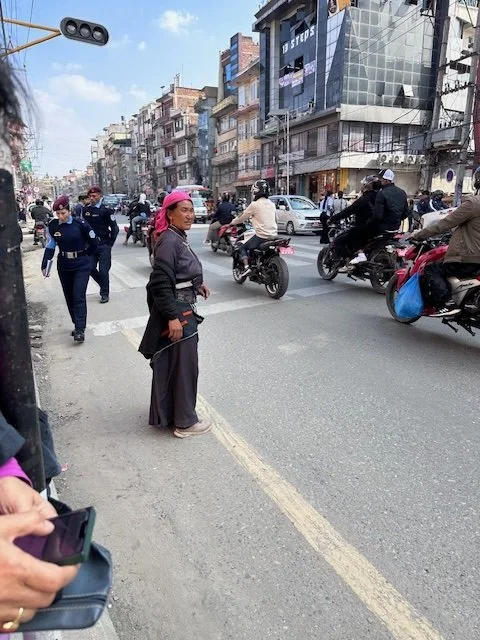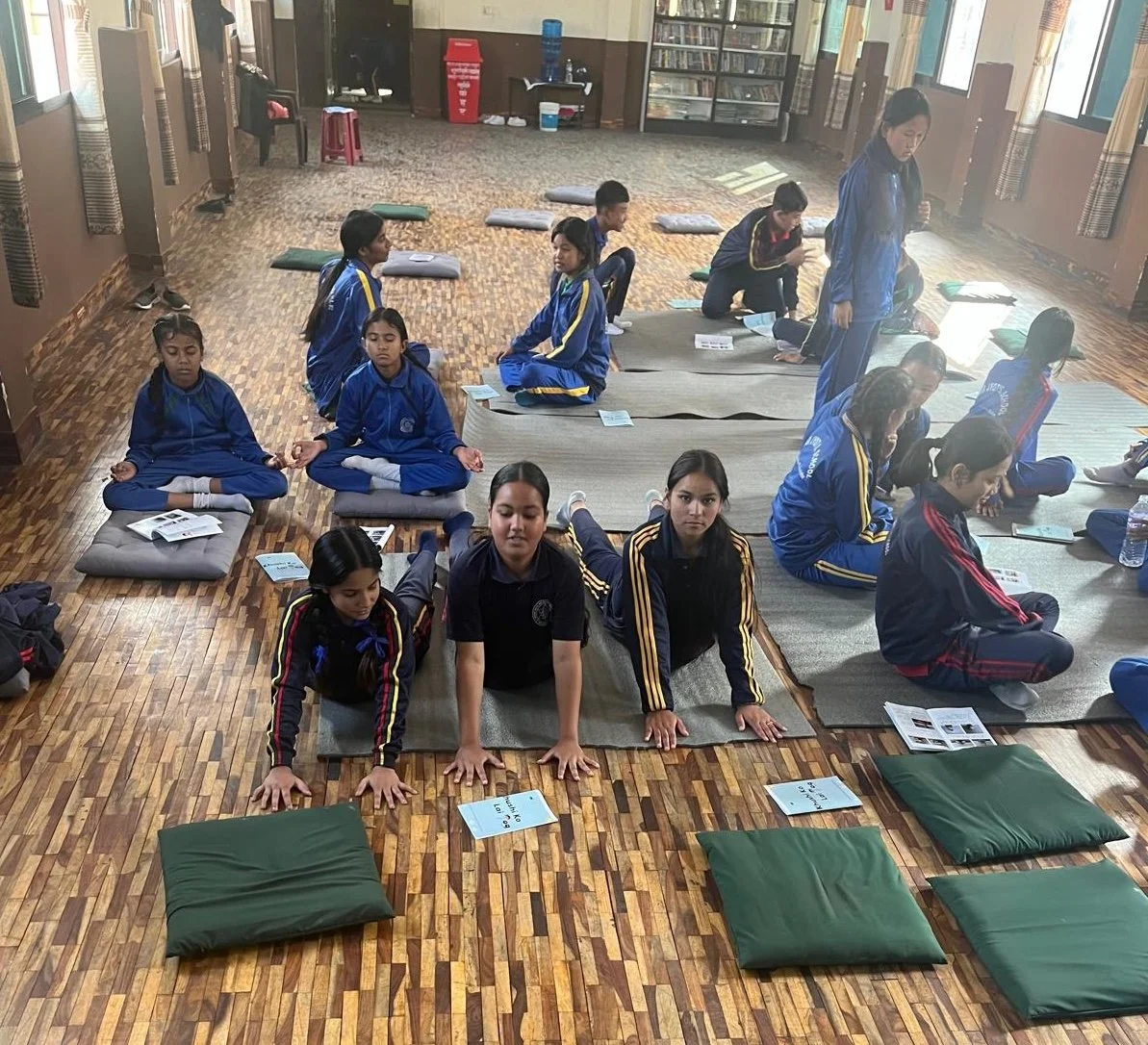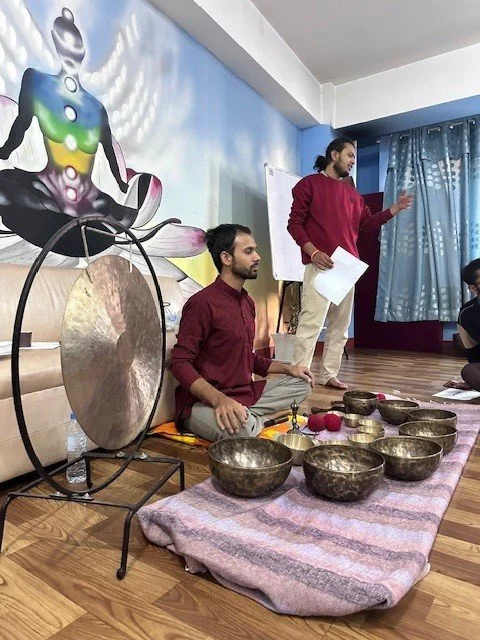Steps to Compassion
I’ve just returned from two weeks in Nepal, which included sessions with schools and yoga teachers, visits to temples and historic sites, and a three-day trek to the Panchase base camp. A journey of a lifetime – deeply inhaling Himalayan air as I gazed out over lush tropical vegetation with carefully manicured terraces – and continuing to climb higher and higher.
Cultivating Happiness in Nepal
While I sought adventure, I was also there to learn and share about CEI’s Cultivating Happiness initiative. One of my takeaways was a deep sense of stillness and peace from this high-elevation experience, and even a profound sense of being blessed with this opportunity. (My utmost thanks to Lata Tulachan, my yogi connection who helped me to manifest 14 days in Nepal, this “land of the Gods.”) And, moreover, a realization that CEI’s five Cs (consciousness, compassion, courage, confidence, and community) were equally relevant to both my journey and also the Nepalese people.
Kathmandu, founded in 723, is one of the oldest cities with continual habitation in the world. With a population of 1.6 million, it is not only an art and economic center for Nepal, but also the governmental seat. Filled with temples and rich with cultural diversity, it is a maze of congested alleyways, with what can seem like more motorcycles than people. Interestingly, Balendra Shaha, the current mayor, has helped to clean up the city, and despite its age, Kathmandu is almost dust-free and far greener, with improved sanitation and waste management compared to the past (Poudel, 2023).
Consciousness, Strife, and Harmony
Even as I write about my love of Nepal, I also realize that whether in cities or on mountain tops, life is not easy – even amidst the bliss. Whether on foot, car, or jeep, reminders of the horrific floods from the previous month—floods killing 230+ people in Kathmandu alone—dotted the landscape. I often heard that “a highway renovation was underway”—and had been underway for several years. Moreover, one-fifth of Nepal’s population live in poverty (Central Bureau of Statistics, 2023). And while rural families in mountainous regions face harsher living conditions, urban migrants often find the adjustment to city life difficult. Overcrowding, low levels of social support, inadequate security, and increased violence contribute to the stress of those dwelling in highly populated areas (Ma, 2021).
Yet, with the Nepalese people I found resilience, serenity and acceptance, and a deep caring for others. As my guide, Deepak, said, “Ma’am, if you are happy, I am happy.” What a mantra for the ages!
As I climbed, and the landscapes unfolded before me, I was in awe of the Nepalese people, who at sharply increasing heights, lived in such peaceful harmony with the land, nimbly running up and down hundreds of steps they have carved into the earth, producing the freshest vegetables, and sifting millet, wheat, rice, and corn to produce their own flours. These self-sufficient mountain farmers lived a simple life, cooking over open fires, with access to minimal electricity. Yet, they also relied on modern machinery to move earth to clear landslides and found a way to serve as hosts for needy trekkers, whether it be through their home stay programs or their “tea houses” that crop up in remote villages. At this time of global warming, a majestic glimpse of how the human species can coexist with nature.
Heart Connections
While one of the highlights of my trip was the upfront view of scenic mountain vistas that extended for miles, my visits with local schools and yoga teachers also surpassed my expectations. Presenting sessions ranging from 90 minutes to 3 hours to both public and private schools, I found teachers, administrators, and students eager to participate and learn. As I taught, I also found rapt interest from my Nepalese educational colleagues as I explained CEI’s vision for heart connections, for learning together, and for humbly seeking a way to bring our joint wisdom and skills to others.
Yoga as a Universal Language
Nepal is currently the only country in the world requiring that yoga be taught in schools (Bhandari & Schultz, 2020). Yet this requirement, which was mandated in 2020, is in its infancy. While meditation in monastery schools has been integral to the lives of students there for centuries, the degree of implementation in public and private schools varies widely. Building on my 25 years of experience as a kundalini yoga teacher, I experienced the delight as eyes lit up and hearts opened to new postures, movements, and meditations. Yoga provided a path to communicate – a universal language – and a shared experience for all of us.
As I taught, I shared both from my book, Cultivating Happiness, Resilience, and Well-Being through Mindfulness, Meditation, and Movement (Mason et al., 2021) and from a small children’s booklet that I co-authored with Chandni Lal that was translated into Nepali. My thanks to Chandni, our translators, and my co-authors who continue to help bring the many blessings of yoga, mindfulness, and meditations to youth and educators.
A Vision for Yoga
As per our Cultivating Happiness book, not only are we striving to bring yoga to teachers, staff, and students in schools, we are aiming to help prepare yoga teachers to assist in schools. Whether this be as “wellness trainers” as Kahlil Kuykendall and Jeff Donald are implementing yoga in Maryland, or in any number of other ways, there seems to be a natural role for connecting yoga instructors with schools.
In Kathmandu, I furthered this vision by sharing a session with some 20 yoga instructors in a local yoga studio where we met for three hours on a Saturday afternoon. Once again, I found enthusiasm for the kundalini approach that has been transformational to my life. For our short time together, we shared meditations and breathwork, as I explained the guidelines from the Cultivating Happiness book. The session ended with a “Sound Bath” of singing bowls followed by CEI’s signature Heart Beaming. We are hoping to stay connected and possibly set up remote sessions to continue to assist in implementation of CEI’s vision in Nepal.
A few Closing Thoughts on Yoga, Meditation and Happiness
Dante Stewart (2024), writing about James Baldwin in Sojourner’s Journal, said, “When we say that all human beings deserve life, liberty, and the pursuit of happiness, the most important part is the happiness that comes from being treated as if you matter, as if your existence is not expendable, as if you count for something and that we are accountable to you and where you exist in the world.”
Even as I explore and promote happiness, both from my home and in my travels, I am increasing my understanding of the wisdom, strengths, and needs of people who may be living far different lives from mine. As I learn, I am finding that my deep sense of compassion is expanding. There is so much that simply cannot be conveyed through media, books, or zoom meetups. I truly believe that we need more and more in-person meetings with others who live at some distance from us.
As the Dalai Lama (1998) has instructed us, “In one sense one could define compassion as the feeling of unbearableness at the sight of another’s suffering. And in order to generate that feeling one must first have an appreciation of the seriousness or intensity of another’s suffering” (p. 94). So even as I seek happiness and bask in the bliss of an amazing adventure abroad, I am reminded that much work remains. Increasing cross-cultural connections is a part of that work. In these times, it may indeed be time to focus more intensely on the lives of others from around the world – to seek to learn from them and share with them.
So yes, living compassionately must include expanding our horizon. However, it also demands action. The journey is sometimes steep, with far too many steps – so many obstacles to overcome. Yet, I returned home knowing that “connecting” with others, connecting at a heart level, is essential – it is life altering. My belief is that solutions will not arise from the comfort of our homes and offices – we need to test ourselves, even push ourselves to stretch our capacity and increase our deep knowing of what is needed and what might work.
Dhanyavaad – My thanks to the many who participated in this journey – to Sabina Rimal with the Can Help Nepal Foundation, to Principal Amit Bikram Sijapati at the Samriddhi Schools, my guide Deepak Shivabhakti, and the many yoga teachers who met with me and want to continue to connect to further our dream.
This article was also published in our Heart Mind newsletter here.
References
Bhandari, R. & Schultz, K. (2020). Nepal makes yoga mandatory for schoolchildren. The New York Times.
Central Bureau of Statistics. (2023). Nepal Living Standards Survey 2022-23: Key findings. Government of Nepal.
Dalai Lama, HH & Cutler, H. (1998). The art of happiness: A handbook for living. Yellow Kite Publisher.
Ma, J. (2021). Urbanization and emerging mental health issues. CNS Spectrums, 26(1), 43-50.
Mason, C., et al. (2021). Cultivating happiness, resilience, and well-being through meditation, mindfulness, and movement: A guide for educators. Corwin Press.
Poudel, A. (2023). Why Kathmandu is visibly cleaner. The Kathmandu Post.
Stewart, D. (2024, November). Do we have the courage to make the world a loving place? Sojourners Magazine.






